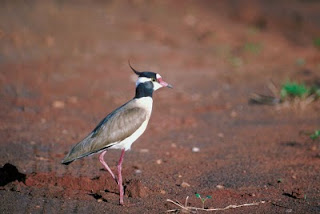The Plover family has two groupings: the Charadriinae, who are the typical Plovers, also known as “Plover” and “Dotterel”, and their close relatives, the Vanellinae, who are the crested Plovers, also called “Lapwings”. The ancient Red-kneed Dotterel (Erythrogonys cinctus) is grouped with the Vanellinae.
Members of the Plover Family are swift running Birds. In addition, these wading Birds are usually found near water, whether it be a small pond or a large lake. Although, the Australian Dotterel (Desert Plover) makes her home in arid regions, She will nest along the margins of streams.
Many Plovers make shallow dirt nests out in the open. However, their eggs look like living pebbles, blending with the soil. Meanwhile, Plover Chicks, after their Parents sound the alarm that an intruder is near, will crouch motionless. Then They will draw back their heads to hide in plain sight. Although Plovers seem to be vulnerable, They have good camoflague.
These small plump Birds are often seen on open shores looking for Worms. Although Plovers are strong fliers, They usually hunt by standing alert actively watching for prey. While standing on one leg, Plovers vibrate the other one lightly on the ground. Attracting Worms by these slight movements, these Birds can easily obtain their next meal.
Among the Plover Family, American Golden Plover (Pluvialis dominica) has one of the most spectacular migrations of any North American Bird. Flying from Arctic Canada, He first stops in Labrador, then He goes non-stop to the northern coast of South America. After resting for awhile in the region of the Amazon River Basin, American Golden Plover then flies to the Pampas of Argentina. Later when the seasons change, He does the whole trip in reverse.
A smaller Member of the Plover Family, European Dotterel is known for her trusting nature. However unlike many other Bird species, the female is the dominant sex. Bigger and more brightly coloured, Female European Dotterel initiates their courtship. After laying her eggs, She leaves her Mate to incubate them whilst She flies off to court another Male.
With their markings, Plovers often blend into the beach, where They live. Foraging for worms, They shake their feet to disguise their movements. Nesting in exposed areas, Plovers have eggs that look like stones.
Plovers demonstrate how to blend in. Call on Plovers to show you how not to be noticed. Only when They quickly run across the ground, stopping only to eat a tasty Mollusk, do you see Them.
------------------
Science Notes:
1. Magellanic Plover, Crab-plover, and Egyptian Plover are in their own groupings and are separate from the Plover Family. Crab-plovers (Dromadida) are unique amongst waders by nesting in burrows that she digs herself. Egyptian Plovers (Pluvianidae) pick leeches off the teeth of crocodiles. Magellanic Plover (Pluvianellidae) are more closely related to Sheathbills (Chionida) than Plovers.
2. These three members of the Plover Family closely resemble each other: American Golden Plover (Pluvialis dominica), European Plover (Pluvialis apricaria), and Pacific Golden Plover (Pluvialis fluva). Only subtle differences can been seen between these three birds.

No comments:
Post a Comment